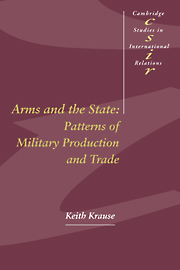Book contents
- Frontmatter
- Contents
- List of figures
- List of tables
- Acknowledgements
- Introduction
- 1 Motive forces in the evolution of the arms transfer and production system
- 2 The emergence of a global arms transfer and production system
- 3 From the Military Revolution to the Industrial Revolution
- 4 An overview of the post-1945 global arms transfer system
- 5 The dominance of first-tier producers and suppliers
- 6 Second-tier producers and suppliers: the struggle to keep pace
- 7 Dependent production and exports in the third tier
- 8 The subordinate role of arms recipients
- Conclusion
- Appendix: Arms transfer data sources and problems
- Notes
- Bibliography
- Index
4 - An overview of the post-1945 global arms transfer system
Published online by Cambridge University Press: 22 September 2009
- Frontmatter
- Contents
- List of figures
- List of tables
- Acknowledgements
- Introduction
- 1 Motive forces in the evolution of the arms transfer and production system
- 2 The emergence of a global arms transfer and production system
- 3 From the Military Revolution to the Industrial Revolution
- 4 An overview of the post-1945 global arms transfer system
- 5 The dominance of first-tier producers and suppliers
- 6 Second-tier producers and suppliers: the struggle to keep pace
- 7 Dependent production and exports in the third tier
- 8 The subordinate role of arms recipients
- Conclusion
- Appendix: Arms transfer data sources and problems
- Notes
- Bibliography
- Index
Summary
The volume of information available on the post-1945 (and especially the post-1960) period allows a much more complete picture to be drawn of the evolution of the arms transfer and production system. Despite some suggestive indications presented in the historical chapters above, the evidence is insufficient for one to draw definitive conclusions on the motive forces driving the system and its evolutionary dynamic. But an unfocused history of arms transfers since 1945 would not be sufficient either, and the historical backdrop is essential to an understanding of contemporary developments in the arms transfer and production system. What follows is a sketch of the post-1945 international arms transfer system that illuminates its outlines and current structure based on the factors that have already been highlighted as critical: technological innovation, the transfer and diffusion of technology and the relationship between production and exports. It concentrates on producers and suppliers; chapter 8 will integrate this discussion with an examination of the role of arms recipients. Chapters 5–7 will present in detail the policies, practices and motivations of the different tiers of producers or suppliers. This will allow the evolution of the contemporary global arms transfer and production system to be placed against the backdrop of historical precedent and account for some of the distinctive features of the current system.
- Type
- Chapter
- Information
- Arms and the StatePatterns of Military Production and Trade, pp. 81 - 98Publisher: Cambridge University PressPrint publication year: 1992

